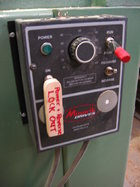odie
TOTW Team
- Joined
- Dec 22, 2006
- Messages
- 7,123
- Likes
- 9,883
In my Minarik manual, it says that damage to the unit is possible if you return to zero rpm by using the potentiometer, and not use the brake. It doesn't say what kind of damage is possible, and that information is what I'm asking for.
Because I have unscrewed a turning, or two from the spindle by solely using the brake, I'm in the habit of first reducing the rpm by using the potentiometer, waiting a second or two, and then hitting the brake. Once in awhile I forget to use the brake, and this is the condition the Minarik manual warns about. So far, I've never seen any problems, but I'm wondering just what kind of damage to the unit is possible.....?
thanks.....
-----odie-----

Because I have unscrewed a turning, or two from the spindle by solely using the brake, I'm in the habit of first reducing the rpm by using the potentiometer, waiting a second or two, and then hitting the brake. Once in awhile I forget to use the brake, and this is the condition the Minarik manual warns about. So far, I've never seen any problems, but I'm wondering just what kind of damage to the unit is possible.....?
thanks.....
-----odie-----

